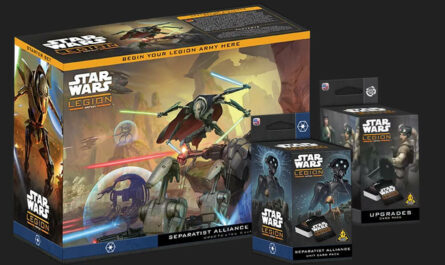In a Star Wars Legion game, you and your opponent take it in turns to activate your units, each of which grants you two actions. Those are needed to reach your objectives. The more actions you take in a game, the more opportunities you have to fulfill your objectives. If you also manage to generate more actions than your opponent, you should have in theory a greater chance of winning the game. This tactical concept is called Action Advantage and needs a word of explanation…
Actions, a question of perspective
When a unit activates, it can perform two actions from among:
- Move
- Attack
- Aim
- Dodge
- Wait
- Recover
- Card action
To understand the concept of action advantage, you need to think of actions as transactions. Your unit has to ‘pay’ for something in order to receive something else in return. It pays an action to move, aim, standby, etc. Since a transaction is an exchange, it works both ways: a move is equivalent to an action, just like a green or standby token. In other words, if a unit receives a Dodge token via a third-party effect, it should be perceived as if it had benefited from a free Dodge action.
What is action advantage?
Action advantage is the process by which a player actually obtains more actions than his opponent. In other words, action advantage occurs when there is a favorable imbalance between the number of actions you have and the number of actions your opponent has. To reverse the balance, you have two levers:
- Increase your action reserve;
- Reduce your opponent’s.
Increase your action reserve
Through the number of activations
If your army list contains 10 activations, you will theoretically have access to 120 actions during a game of 800 pts (10 activations x 2 actions x 6 turns). If your opponent only has 8 activations, he starts his first turn with a deficit of 24 actions compared to your army! This potentially represents 12 extra fire actions for you. Unfortunately, during the course of the game, players will suffer losses and the balance will sometimes tip one way, sometimes the other. Given that this gap varies constantly over the course of the game, it’s best to diversify your sources of action advantage.
Through unit keywords
Unit keywords are excellent ways of generating action advantage, as some of them generate free actions.
For example, the Steady ability allows you to perform an attack action after making a move. The Gunslinger ability allows you to perform a second ranged attack action after the first. These keywords generate action advantage because the unit has access to two actions for the price of one.
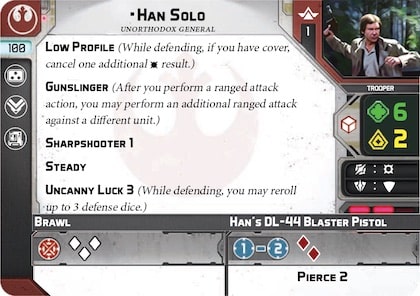
To illustrate, let’s take the case of Commander Han Solo who has the two abilities mentioned above. By moving, Han Solo performs a transaction that gives him a net gain of two actions: he “pays” one action to “receive” a move + a ranged attack (thanks to Steady) + a second attack (thanks to Gunslinger). So when Han Solo moves, he allows you to generate a two-action lead (or catch up) over your opponent.
You could use this maneuver to get closer to an objective while attacking your opponent. If he wanted to do the same with a third party unit, it would have cost him two activations to draw 4 actions.
Similarly, Iden Versio’s Quick Thinking ability allows her to spend an action to receive a Dodge and an Aim token. Once again, this transaction gives you a net gain of one action, as the two green tokens have an individual value of one action each. Do you grasp the principle?
| Mercenaries at their best? The Independent keyword on the mercenary profile cards generates tokens if the unit in question has not received an order during the command phase. As you may have guessed, this ability is powerful in terms of action advantage. It’s as if these mercenaries had virtually 3 actions per turn, one of which must be spent on an Aim, Dodge or Standby token. |
Command cards
Most command cards generate free actions and are therefore your second major source of action advantage. Let’s take Darth Vader’s command cards as an example:
- New Motivation Techniques gives two units a free action in exchange for a wound.
- Implacable on the other hand gives Luke’s father two Dodge tokens and an extra half-action, giving a net action advantage of 3!
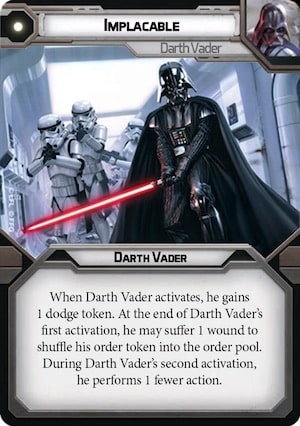
Command cards combine very well with keywords. To stay with the Darth Vader example, remember that he has the keyword Relentless. This gives him a free attack action after a move. So potentially, Vader could generate a net action advantage of 5 thanks to the Relentless card if he manages to trigger his Relentless ability during his two activations. No wonder he’s considered the master of evil…
Enquipment cards
Upgrade cards also have their part to play in this action race. The Prepared Equipment and Emergency Transponder cards, for example, offer a green token to the unit that has equipped itself with them, virtually a free Aim or Dodge action! As for Up Close and Personnal, it requires a short-range attack to obtain a Dodge token, a reward that can be triggered several times per game, or even per activation! This card is devilishly effective when used on Han Solo – I’ll leave you to calculate the net gain…

Through free Standby tokens
If a game effect offers a free Standby token to a unit, and you manage to use it, you generate action advantage. Usually, a unit obtains this type of token via the Standby action. In this case, the unit simply postpones an action (move or attack), and does not modify its action reserve. On the other hand, receiving a Standby token for free results in a gain of one action (or several actions if you combine it with other effects). The Lando Calrissian and Cassian Andor command cards are a good illustration of this.
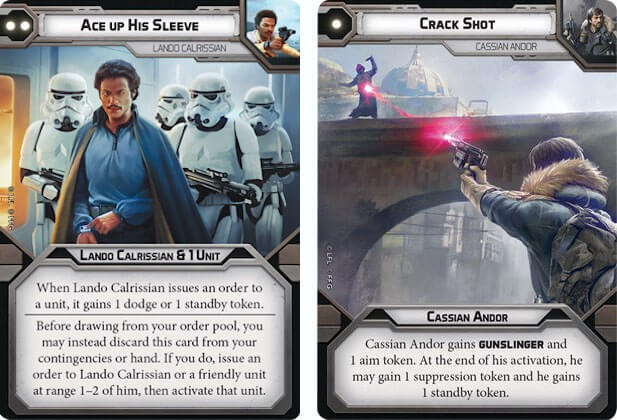
Reducing your opponent’s action reserve
Finally, if you don’t manage to generate any extra actions then why not reduce the number of actions your opponent has ? Remember, the most important thing is to widen the gap between yours and the ones of your opponent!
Using Suppression tokens
Suppression is an anti-game technique available to every faction. When a unit has more or as many suppression tokens as its courage value after its Rally test, it loses an action on activation. With your suppression shots, you can therefore remove a few actions here and there from your opponent. Some army lists, such as this one by Orson Krennic, use them as their spearhead.
Suppressing enemy units
I don’t need to draw you a picture. It’s obvious but it had to be added to the list. The fewer units your opponent has, the fewer activations he will have and therefore less actions. If you kill one of its unit on turn 1, you remove all the actions that unit would have generated over the next five turns, i.e. 10 actions.
The limits of action advantage
Value your advantage
Imagine yourself stranded on a deserted island in the middle of the Pacific Ocean. While searching the island, you come across a briefcase containing $1,000,000. Do you burst with joy ? No, because you won’t be able to eat or drink on your desert island. In other words, the context in which you find yourself at a given moment dictates the value of any advantage you might receive.
Getting back to Star Wars Legion, there’s no point in generating additional actions if they have no impact on the game. Tokens only have value if they are actually used or if they deter your opponent from attacking. For example, the Tauntaun Riders’ Agile 1 keyword which allows them to gain a Dodge token each time they move, cannot be considered as action advantage if these beasts are out of range of any opposing unit.
You can turn this to your advantage. Don’t waste your time (and your actions) attacking your opponent when he generates a pack of Dodge tokens. Concentrate on your objectives that turn, neglect his green tokens and therefore his attempt to create action advantage. Did not anticipate this, Republic, did you ?
Quantity is not always the solution to your problems
Furthermore, does gaining the upper hand over your opponent necessarily depend on the number of actions you take? No, of course not. Action advantage is not enough to win your games but it contributes greatly to them. By combining it with other tactics, such as virtual action advantage, you can considerably improve your chances of winning the game.
Conclusion
By revealing this game design concept to you, you are now in a position to explain in concrete terms why Tauntaun Riders are some of the best units in the game! All jokes aside, understanding action advantage should enable you to improve your army lists by effectively identifying the value of your units and cards. Review your current army list and try to identify the number of actions it can generate over the course of a game. Then adjust a few cards/units to increase your action reserve. Also keep an eye out for updates to the rules of the game, which sometimes hide new ways of gaining an advantage. You may even have spotted other action advantage sources that I haven’t mentioned in this article…
Finally, beyond the tactical aspect, remember that a greater reserve of action means that you’ll play more and therefore have more fun!
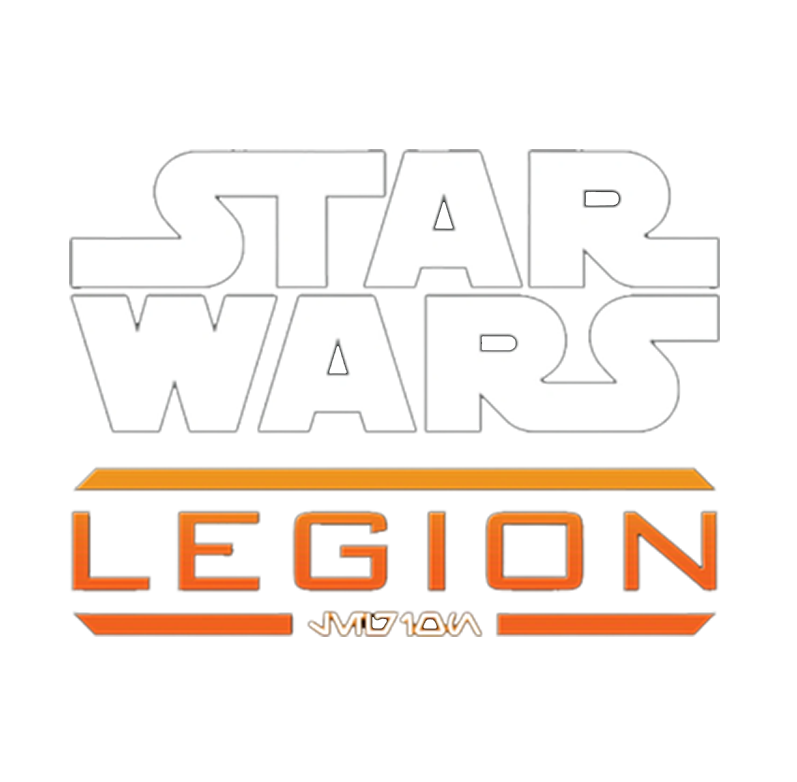
Need advice building your army list?
Join your country’s Star Wars: Legion Discord community and get answers to your questions.


